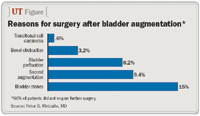Article
Data shed light on bladder augmentation risks
Washington--Long-term experience with bladder augmentation in children is now giving pediatric urologists and parents a true picture of the risks and benefits of different bowel segments. No single segment was the obvious winner in two experimental studies presented here at the American Academy of Pediatrics Section on Urology annual meeting, but the maintenance and surveillance required has become clearer. Other than technical considerations, metabolic, rather than urodynamic considerations, may prove more important in deciding which segment to use.

In these studies, a group from the James Whitcomb Riley Hospital for Children and Indiana University School of Medicine in Indianapolis reviewed their experience with 500 augmentations performed between 1978 and 2003, and a group from Juntendo University School of Medicine in Tokyo reviewed their experience with 86 sigmoid cystoplasties followed up for at least 10 years and as long as 21 years.
Today, most augmentations at Indiana are done using ileum, said study presenter Peter D. Metcalfe, MD, a fellow in pediatric urology at Indiana University School of Medicine working with Richard Rink, MD. Ileum accounted for 61% of augmentation segments, but sigmoid colon (19%) and cecal (9%) augmentations also were performed, primarily early in the series. Gastric (9%) and ureteric segments (2%) were also used when indicated and available. More than half (359) of these augmentations were done for neuropathic bladders, mainly in children with spina bifida.
Malignancy occurred in patients with both ileocecal and cecal segments at a mean age of 37 years. Mean age at augmentation was 19 years. Whether the augmentation or other risks for TCC played a role wasn't clear for this most feared complication.

Perforation risk
The risk of perforation was highest with sigmoid augmentations and was also related to the type of bladder outlet surgery performed. The perforation risk was highest with a formal bladder neck procedure (28%). With no bladder neck procedure, the risk of perforation was 4%, and if a bladder neck sling was performed, the risk was 1.9%. Using a catheterizable channel carried less risk (6%) than no channel (11%), "presumably, because of the increased compliance with intermittent catheterization and chronically lower intravesical pressures," Dr. Metcalfe said.
Gastric segments did have a higher risk of bowel obstruction. Secondary augmentation for decreased compliance or incontinence was done in 47 patients (9.4%), less often in bladders with ileal segments (4%) than with any other segment.
Compared with the other segments (17%), gastric segments carried a lower risk of stone formation (2%). More remarkable was the increased stone risk associated with the use of a catheterizable channel (20%) compared with no channel (10%), possibly because of complete emptying.
Regularly irrigating through the catheterizable channels with plain water is a preventive measure taken by Howard Snyder, MD, professor of urology in surgery, University of Pennsylvania School of Medicine, Philadelphia. Although the Indiana urologists did not include irrigation in their analysis, in recent years, they highly recommend at least daily irrigation and monitoring the ability to empty with ultrasound, Dr. Rink said.
Dr. Rink pointed out that patients in this series seemed to either have no problems (66%) or multiple problems. That is, if patients had one complication, they tended to have more: one complication begets another.
Japanese perspective




